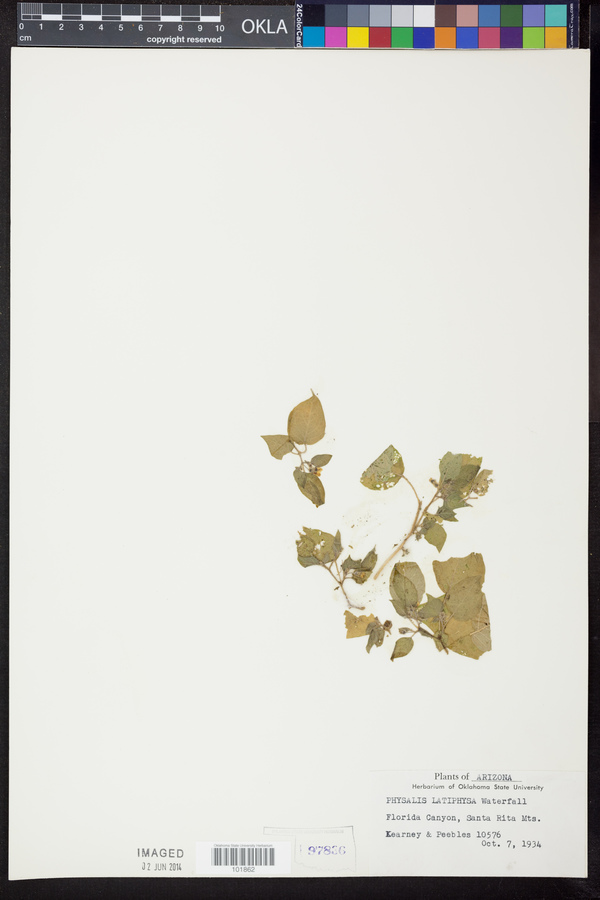Physalis latiphysa
|
|
|
|
Family: Solanaceae
broadleaf groundcherry, more...broad-leaf ground-cherry (es: tomatillo)
|
Description: Herbaceous annual 15-45 cm (6-18 in) tall, commonly hairy, with branched leafy stems. Thin translucent leaf-blades range from ovate to broader than long, 5-7 cm (2-2.8 in) long, with or without a few teeth; the leaf-stalk is about as long as the blade. Petiles are 1.5-7 cm (0.6-2.8 in) long. Solitary flowers with calyces 3-4 mm long with lobes about half that long on lateral peduncles that are 3-8 mm long. The yellow corollas are dark-spotted and small, 4-6 mm long. Fruiting calyces with sparsely appressed hair, strongly 5-angled, 2.5-4 cm long and 3-4 cm wide. Fruiting berry globose, seeds many and flat. Habitat: Washes, often in the shade of shrubs and boulders, in desertscrub or grasslands Substrate: Granitic gravelly soils. AGFD 2004, Kearney and Peebles 1969, McDougall 1973 Duration: Annual Nativity: Native Lifeform: Forb/Herb General: Herbaceous annuals, 15-45 cm tall, stems branching, leafy, herbage hairy. Leaves: Alternate, ovate to broader than long, 5-7 cm long, thin and translucent, margins dentate with a few teeth to entire, petioles 1.5-7 cm long. Flowers: Yellow with dark spots, corollas open-campanulate, 5-lobed, 4-6 mm long, calyx campanulate, 5-toothed, 3-4 mm long, lobes 1-2 mm long, becoming enlarged and inflated in fruit, 5-angled, stamens 5, inserted near the base of the corolla tube, anthers oval to oblong, dehiscing longitudinally, flowers solitary on lateral peduncles 3-8 mm long. Fruits: Berries globose, surrounded by an enlarged calyx, this with sparsely appressed hair, strongly 5-angled, 2.5-4 cm long and 3-4 cm wide. Seeds numerous, flat. Ecology: Found on gravelly, granitic soils, in washes, often in the shade of shrubs and boulders, in desert scrub, grasslands, mixed shrublands, and riparian forest communities, from 3,000-5,000 ft (914-1524 m). Distribution: Arizona only. AGFD note that this species is known to occur in the San Bernardino Valley in Cochise County, the Pinaleno Mountains in Graham County, the vicinity of Arivaca Creek in Pima County, and the Santa Cruz River in Santa Cruz County. Notes: Distribution information taken from USDA Plants and the Arizona Game and Fish Department. The flowering phenology of this species is reportedly unknown, and this species would be a good candidate for further study. Kearney and Peebles and McDougall used for genus information only. Ethnobotany: There is no use recorded for this species, but other species in this genus have uses. Synonyms: None Editor: LCrumbacher 2012 Etymology: Physalis comes from the Greek physalis, "a bladder or bubble," because of the inflated calyx, while the meaning of latiphysa is partially from the Latin latus for broad, and the Greek physa or bellows for the bladdery fruit. |


